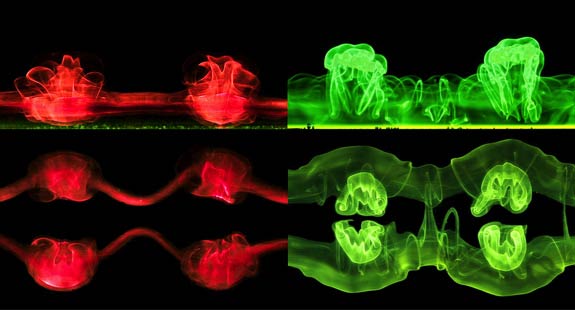Pair of Counter-Rotating Vortices in Ground Effect
Daniel J. Asselin
Charles H.K. Williamson
Fluid Dynamics Research Laboratories
Sibley School of Mechanical and Aerospace Engineering
Cornell University
Ithaca, New York

Image Credit: D.J. Asselin & C.H.K. Williamson (Cornell University, Ithaca, NY) Figure 1.

Image Credit: D.J. Asselin & C.H.K. Williamson (Cornell University, Ithaca, NY)Figure 2.
Primary vortices (red) generated in water by a pair of rotating flaps and secondary vortices (green) generated upon interaction of the primary vortices with a solid boundary.
The interaction of a pair of counter-rotating vortices with a solid boundary is a problem of fundamental interest to many areas of fluid mechanics, as well as to practical applications in which vortices interact with the ground or with vehicles in air or water. These vortices are subject to both short-wavelength and long-wavelength instabilities. The focus of this study concerns the evolution of vortices initially subject to the long-wavelength instability, which then interact with a wall.
A vortex pair is generated in a water tank using a pair of rotating flaps that span the length of the tank. The interaction of these primary vortices (red) with a solid horizontal wall within the tank leads to the formation of secondary vortices (green). The two sets of images were taken ten seconds apart and show the vortices from the side (top two images in each set) and from below (bottom two images in each set).
Upon interacting with the ground plane, significant flow is directed along the axis of each primary vortex (shown in red). This leads to the periodic concentration of fluid containing vorticity at the peaks of the initially wavy vortex line. In the secondary vortices (shown in green), vortex rings appear to develop from rising vortex loops.
This research was supported by the Office of Naval Research.
Reporters and Editors
This image can be freely reproduced with the accompanying credit: "D.J. Asselin & C.H.K. Williamson (Cornell University, Ithaca, NY)."
References
- Crow, S.C.(1970) Stability Theory for a Pair of Trailing Vortices. AIAA J., 8 (12), 2172-2179.
- Tsai, C.-Y. & Widnall, S.E. (1976) The stability of short waves on a straight vortex filament in a weak externally imposed strain field. J. Fluid Mech., 73 (04), 721-733.
- Widnall, S.E., Bliss, D.B., and Zalay, A. (1971) Theoretical and experimental study of the stability of a vortex pair. In: Aircraft Wake Turbulence and Its Detection. New York, Plenum Press, 1971., pp. 305-338.
- Widnall, S.E., Bliss, D.B., and Tsai, Chon-Yin. (1974) The instability of short waves on a vortex ring. J. Fluid Mech., 66 (01), 35-47.
Contact Information
Daniel J. Asselin
Fluid Dynamics Research Laboratories
Sibley School of Mechanical and Aerospace Engineering
Cornell University
dja222@cornell.edu
